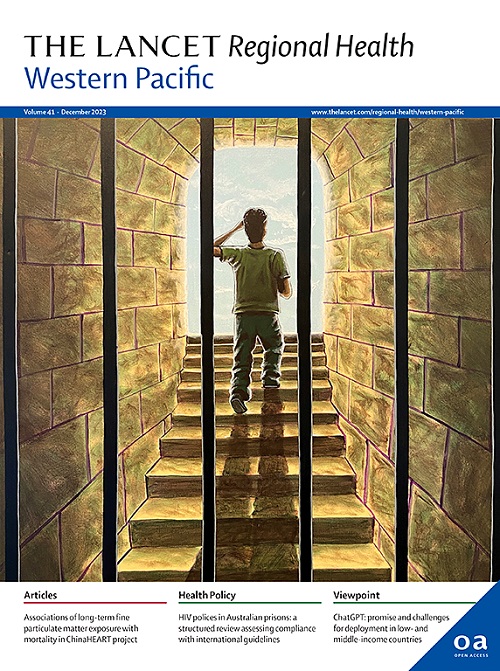Implementation of a best-practice model of care for cognitive impairment and dementia for first nations peoples attending primary care in Australia: a stepped-wedge cluster-randomised trial
IF 8.1
1区 医学
Q1 HEALTH CARE SCIENCES & SERVICES
引用次数: 0
Abstract
Background
Dementia and cognitive impairment not dementia (CIND) are under-detected amongst First Nations peoples attending primary care. This trial implemented a culturally adapted best-practice model of care to increase detection and optimise management of CIND/dementia.
Methods
This closed cohort open-label, stepped-wedge, cluster-randomised trial recruited 12 Aboriginal community-controlled primary health care services (ACCHSs) across urban, regional and remote settings in Australia. ACCHSs were eligible to participate if they conducted annual health checks, engaged in continuous quality improvement processes and had ≥55 clients aged ≥50 years. After a baseline control period, four ACCHSs were scheduled to enter the intervention phase every six months. During the intervention phase, ACCHSs were supported to embed best-practice dementia care through staff education and practice change initiatives. Co-primary outcomes were: (i) documented detection of CIND/dementia and, (ii) evidence of uptake of the diagnostic pathway measured as presence of ≥2 of: use of cognitive assessment tools, relevant pathology investigations, neuroimaging, and/or referral of clients with cognitive concerns to specialist services. Data were analysed with mixed effects complementary log–log regression. This study was registered with the Australia and New Zealand Clinical Trials Registry, ACTRN12618001485224.
Findings
Between September 2018 and January 2019, 12 ACCHSs were recruited, comprising a sample of 1655 ACCHS clients aged ≥50 years (mean 60.3 ± 8.2 years), of whom 935 (56.5%) were female. One ACCHS withdrew during the study. After adjustment for time, the intervention did not show evidence of an effect for the first co-primary outcome (detection of CIND/dementia): HR = 1.53 (95% CI 0.64, 3.65). However, the intervention improved the second co-primary outcome (uptake of diagnostic pathway): HR = 2.34 (95% CI 1.05, 5.25). Intention-to-treat analyses yielded similar results.
Interpretation
The co-developed best-practice model of care for cognitive impairment and dementia for Aboriginal and Torres Strait Islander people attending primary care improved the diagnostic CIND/dementia management process.
Funding
National Health and Medical Research Council (Australia) and Dementia Training Australia.
澳大利亚第一民族参加初级保健的认知障碍和痴呆护理的最佳实践模式的实施:一项楔步聚类随机试验
在接受初级保健的原住民中,痴呆症和认知障碍(CIND)未被发现。该试验实施了一种与文化相适应的最佳护理实践模式,以增加CIND/痴呆的检测和优化管理。方法:这项封闭队列、开放标签、楔形步进、集群随机试验在澳大利亚的城市、地区和偏远地区招募了12个土著社区控制的初级卫生保健服务机构(ACCHSs)。如果acchs每年进行健康检查,参与持续的质量改进过程,并且有≥55名年龄≥50岁的客户,则有资格参加。在基线对照期后,计划每六个月对四家acchs进行干预。在干预阶段,通过员工教育和实践变革举措,支持社区卫生服务机构纳入最佳痴呆症护理做法。共同主要结局是:(i)记录的CIND/痴呆的检测,(ii)采用诊断途径的证据,即存在≥2项:使用认知评估工具,相关病理调查,神经影像学,和/或将有认知问题的客户转介到专科服务。数据分析采用混合效应互补对数-对数回归。本研究已在澳大利亚和新西兰临床试验注册中心注册,注册号为ACTRN12618001485224。在2018年9月至2019年1月期间,招募了12家ACCHS,包括1655名年龄≥50岁(平均60.3±8.2岁)的ACCHS客户,其中935名(56.5%)为女性。一名ACCHS在研究期间退出。经时间调整后,干预没有显示出对第一个共同主要结局(CIND/痴呆的检测)有影响的证据:HR = 1.53 (95% CI 0.64, 3.65)。然而,干预改善了第二个共同主要结局(诊断途径的吸收):HR = 2.34 (95% CI 1.05, 5.25)。意向治疗分析也得出了类似的结果。共同开发的原住民和托雷斯海峡岛民接受初级保健的认知障碍和痴呆症护理最佳实践模型改善了CIND/痴呆症的诊断管理过程。资助国家卫生和医学研究委员会(澳大利亚)和澳大利亚痴呆症培训。
本文章由计算机程序翻译,如有差异,请以英文原文为准。
求助全文
约1分钟内获得全文
求助全文
来源期刊

The Lancet Regional Health: Western Pacific
Medicine-Pediatrics, Perinatology and Child Health
CiteScore
8.80
自引率
2.80%
发文量
305
审稿时长
11 weeks
期刊介绍:
The Lancet Regional Health – Western Pacific, a gold open access journal, is an integral part of The Lancet's global initiative advocating for healthcare quality and access worldwide. It aims to advance clinical practice and health policy in the Western Pacific region, contributing to enhanced health outcomes. The journal publishes high-quality original research shedding light on clinical practice and health policy in the region. It also includes reviews, commentaries, and opinion pieces covering diverse regional health topics, such as infectious diseases, non-communicable diseases, child and adolescent health, maternal and reproductive health, aging health, mental health, the health workforce and systems, and health policy.
 求助内容:
求助内容: 应助结果提醒方式:
应助结果提醒方式:


